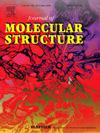Synthesis of 1,3-oxazines based on piperazine
IF 4
2区 化学
Q2 CHEMISTRY, PHYSICAL
引用次数: 0
Abstract
The oxazines bearing piperazinyl moieties namely 2-(tert-butyl)-6-((4-(2-(8-(tert-butyl)-6-methyl-2H-benzo[e][1,3]oxazin-3(4H)-yl)ethyl)piperazin-1-yl)methyl)-4-methylphenol (1) and its corresponding 2,4-di-tert-butyl-6-((4-(2-(6,8-di-tert-butyl-2H-benzo[e]-[1,3]oxazin-3(4H)-yl)ethyl)piperazin-1-yl)methyl)phenol (2), which was previously isolated were described. The transformation of the piperazinyl tri-tert-butyl-phenol derivatives 6,6′-(((2-(4-(3-(tert-butyl)-2-hydroxy-5-methylbenzyl)piperazin-1-yl)ethyl)-azanediyl)bis-(methylene))bis-(2-(tert-butyl)-4-methylphenol) 3 and 6,6′-(((2-(4-(3,5-di-tert-butyl-2-hydroxybenzyl)piperazin-1-yl)ethyl)-azanediyl)-bis(methylene))bis(2,4-di-tert-butyl-phenol) 4 into 1 and 2, respectively was achieved in high yield by heating and stirring a methanolic solution containing Et3N and Ga(NO3)3·6H2O in the stochiometric ratio 1:3:1 for 30 min. The novel oxazine-piperazine 1 together with its triphenol-piperazine 3 (H3L4) were structurally characterized by spectroscopic and single crystal X-ray crystallography.
以哌嗪为基础合成 1,3-噁嗪类化合物
含有哌嗪基的噁嗪类化合物,即 2-(叔丁基)-6-((4-(2-(8-(叔丁基)-6-甲基-2H-苯并[e]-[1,3]恶嗪-3(4H)-基)乙基)哌嗪-1-基)甲基)-4-甲基苯酚 (1) 及其相应的 2、描述了之前分离出的 4-二叔丁基-6-((4-(2-(6,8-二叔丁基-2H-苯并[e]-[1,3]恶嗪-3(4H)-基)乙基)哌嗪-1-基)甲基)苯酚 (2)。哌嗪基三叔丁基苯酚衍生物 6,6′-(((2-(4-(3-(叔丁基)-2-羟基-5-甲基苄基)哌嗪-1-基)乙基)-氮杂二基)双-(亚甲基))双-(2-(叔丁基)-4-甲基苯酚)3 和 6,6′-(((2-(4-(3、通过加热和搅拌含有 Et3N 和 Ga(NO3)3-6H2O(化学计量比为 1:3:1 的甲醇溶液加热搅拌 30 分钟。新型噁嗪-哌嗪 1 及其三苯酚-哌嗪 3 (H3L4) 通过光谱和单晶 X 射线晶体学进行了结构表征。
本文章由计算机程序翻译,如有差异,请以英文原文为准。
求助全文
约1分钟内获得全文
求助全文
来源期刊

Journal of Molecular Structure
化学-物理化学
CiteScore
7.10
自引率
15.80%
发文量
2384
审稿时长
45 days
期刊介绍:
The Journal of Molecular Structure is dedicated to the publication of full-length articles and review papers, providing important new structural information on all types of chemical species including:
• Stable and unstable molecules in all types of environments (vapour, molecular beam, liquid, solution, liquid crystal, solid state, matrix-isolated, surface-absorbed etc.)
• Chemical intermediates
• Molecules in excited states
• Biological molecules
• Polymers.
The methods used may include any combination of spectroscopic and non-spectroscopic techniques, for example:
• Infrared spectroscopy (mid, far, near)
• Raman spectroscopy and non-linear Raman methods (CARS, etc.)
• Electronic absorption spectroscopy
• Optical rotatory dispersion and circular dichroism
• Fluorescence and phosphorescence techniques
• Electron spectroscopies (PES, XPS), EXAFS, etc.
• Microwave spectroscopy
• Electron diffraction
• NMR and ESR spectroscopies
• Mössbauer spectroscopy
• X-ray crystallography
• Charge Density Analyses
• Computational Studies (supplementing experimental methods)
We encourage publications combining theoretical and experimental approaches. The structural insights gained by the studies should be correlated with the properties, activity and/ or reactivity of the molecule under investigation and the relevance of this molecule and its implications should be discussed.
 求助内容:
求助内容: 应助结果提醒方式:
应助结果提醒方式:


